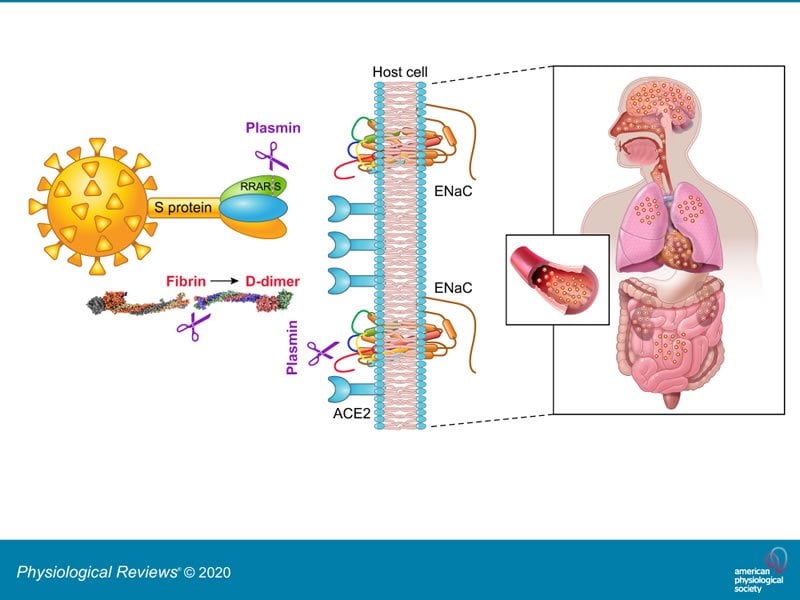Summary: Higher levels of plasmin, an enzyme involved in blood clotting prevention, enhances the virulence and infectivity of SARS-CoV-2 by cleaving its spike proteins. Enhanced levels of plasmin are common in a range of diseases, including diabetes and heart disease. The findings shed light on why those with hypertension and diabetes are at increased risk of complications following coronavirus infection.
Source: American Physiological Society
A new review suggests that higher-than-normal levels of an enzyme involved in blood clot prevention may be a common risk factor for developing COVID-19—a respiratory disease caused by the novel coronavirus SARS-CoV-2—in some populations. The review is published in Physiological Reviews.
People with diabetes, high blood pressure and heart, lung or kidney disease have a higher risk of developing COVID-19. In addition, people with preexisting medical conditions typically become sicker when infected with SARS-CoV-2 than those in otherwise good health. Research has found that one of the leading causes of death from COVID-19 is hemorrhage or bleeding disorders and that one of the characteristics of the disease is overactivity of the system responsible for removing blood clots (hyperfibrinolysis).
Elevated levels of plasminogen and plasmin have been found to be a common factor in people with diabetes and preexisting heart, lung and kidney conditions. Plasminogen is an inactive substance in the blood. When substances in the cells of the blood vessels activate plasminogen, it generates plasmin, an enzyme that removes blood clots from the blood. Higher-than-normal levels of both of these chemicals can lead to severe bleeding.

Studies report that more than 97% of people hospitalized with COVID-19 have increased levels of D-dimer, a protein in the blood that is produced when a blood clot dissolves. D-dimer levels are associated with the amount of virus detected in the body and continue to rise as the severity of COVID-19 increases. This is particularly true in people who develop the often-fatal complication of acute respiratory distress syndrome (ARDS). “In contrast, D-dimer levels decreased to control levels in [COVID-19] survivors or non-ARDS patients,” the review’s authors wrote. “The time [period] for the elevated D-dimer [to go] down in mild [cases] or survivors is dependent. Generally, it takes at least one week for mild [cases] but longer for severe patients,” explained Hong-Long Ji, MD, PhD, corresponding author of the review.
“Measurements of plasmin(ogen) levels and its enzymatic activity may be important biomarkers of disease severity” in people with COVID-19, the authors wrote. In addition, treating hyperfibrinolysis “may prove to be a promising strategy for improving the clinical outcomes of patients with [additional medical] conditions,” they added.
About this neuroscience research article
Source:
American Physiological Society
Media Contacts:
News Room – American Physiological Society
Image Source:
The image is credited to Hong-Long Ji, Runzhen Zhao, Sadis Matalon, and Michael A. Matthay..
Original Research: Open access
“Elevated Plasmin(ogen) as a Common Risk Factor for COVID-19 Susceptibility”. by Hong-Long Ji, Runzhen Zhao, Sadis Matalon, and Michael A. Matthay.
Physiological Reviews doi:10.1152/physrev.00013.2020.
Abstract
Elevated Plasmin(ogen) as a Common Risk Factor for COVID-19 Susceptibility
Patients with hypertension, diabetes, coronary heart disease, cerebrovascular illness, chronic obstructive pulmonary disease, and kidney dysfunction have worse clinical outcomes when infected with SARS-CoV-2, for unknown reasons. The purpose of this review is to summarize the evidence for the existence of elevated plasmin(ogen) in COVID-19 patients with these comorbid conditions. Plasmin, and other proteases, may cleave a newly inserted furin site in the S protein of SARS-CoV-2, extracellularly, which increases its infectivity and virulence. Hyperfibrinolysis associated with plasmin leads to elevated D-dimer in severe patients. The plasmin(ogen) system may prove a promising therapeutic target for combating COVID-19.
Feel Free To Share This Neuroscience News.






